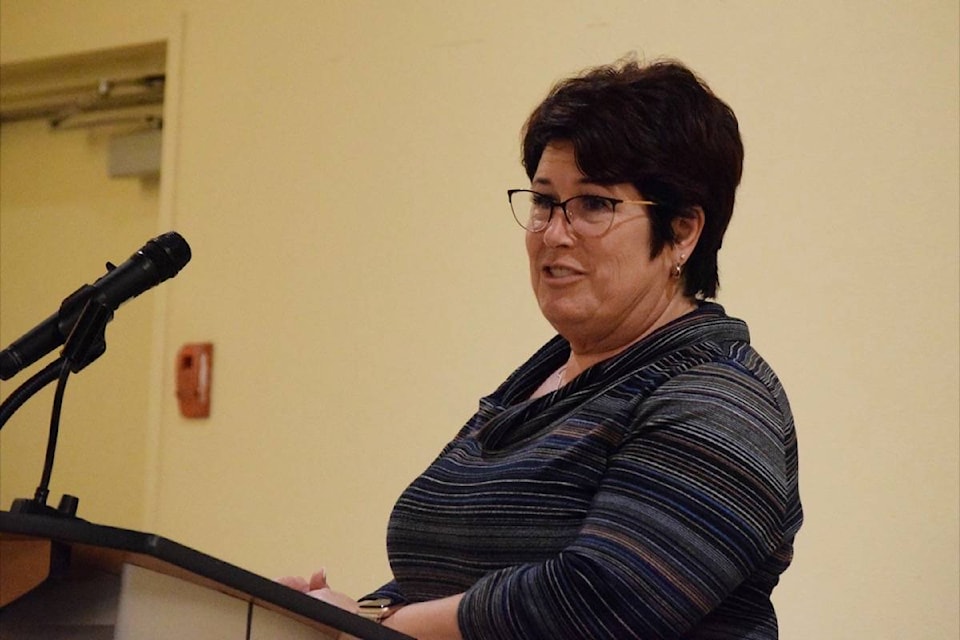The provincial opioid crisis is hitting First Nations communities harder than others, according to experts at a forum held in the Alberni Valley last week.
Port Alberni’s Community Action Team (CAT) hosted a public information session at the Best Western Plus Barclay Hotel on Thursday, Oct. 24, which drew representatives from healthcare, RCMP and people with lived experience to share their stories.
Medical Health Officer Dr. Paul Hasselback started with some of the successes in Port Alberni’s response to the opioid crisis. With 500 people in the community estimated to have an opioid use disorder, Hasselback said the crisis started with about 18 percent of those people seeking treatment. The number is now up to 44 percent, or 220 individuals.
“It’s absolutely amazing,” he said. “It’s probably the best response we’ve seen of any community on the Island, and perhaps one of the better ones in the entire province.”
But despite the successes, Hasselback said that the opioid crisis is an “exceptional burden” carried by First Nations people. Provincially, the risk for an overdose fatality is about four times higher than it is for non-Indigenous peoples. For Indigenous women, it’s about seven to nine times higher. And worst of all, the gap between Indigenous and non-Indigenous seems to be increasing.
“It’s time that we start thinking differently about how to address the issues for Indigenous Peoples, where the burden is so high,” he said, adding that the inequalities are fueled by discrimination, racism and colonialism, as well as structural barriers.
“We all have a piece of that that we need to own and to reconcile,” he finished.
Colleen Salter, a regional addictions specialist with the First Nations Health Authority (FNHA), explained that she spent a few years working in the “conventional” health care system and witnessed inequities in First Nations care, as well as a lack of cultural awareness and safety.
“These inequities are further complicated by poverty, addiction, a disconnection from culture,” she said.
People need access to a home or family in order to heal, she explained.
“So many people have been removed from home and don’t have connection with their community,” she said. “That is our job as health care workers, is to provide people with connection and love and safe care so that they can explore their recovery path. The opposite of addiction is not sobriety—it’s connection.”
In 2018, she explained, 193 First Nations men and women overdosed fatally in B.C., a number which comprises 12.8 percent of all overdose deaths in the province. “The gap between First Nations and non-First Nations is now getting wider,” she said.
She attributes this to systemic racism and stigma, access to treatment and the effects of untreated and unresolved intergenerational trauma, stemming from Canada’s residential schools, which is directly associated with a higher risk of substance use.
Health care professionals need to lessen these gaps and improve services, said Salter.
“Preventing people from dying is our No. 1 priority,” she said.
Rita Watts, a woman from Tseshaht and Hupacasath First Nations, talked about her own experience struggling with addiction. After spending 22 years addicted to crack cocaine, she has now been sober for seven years.
She reached out to the Nuu-chah-nulth Tribal Council’s Quu’asa program for help.
“I told them I need help, I can’t do this anymore,” she said. “I got help, I screamed for it. I got everything that I reached out for.”
She admitted that she still sees family and friends struggling with addiction.
“It doesn’t matter that they’re an addict,” she said. “They still have a heart, they still breathe and they still know how to love. They’re taking that love into the drug. It’s hard getting them out of it.”
The forum closed with Dr. Shane Longman, a physician in Port Alberni, talking a bit about opioid agonist therapy, which is a treatment that prevents withdrawal symptoms. Although it is “very successful,” said Longman, it’s only “the first part” of recovery.
“It opens the door to an individual who otherwise might spend the majority of their day either using or seeking resources to then use again,” he explained.
A few audience members wanted to know if a person could be “forced” onto opioid agonist therapy. Longman replied that forced treatment will not work.
“This is only a door to open the healing of everything else,” he explained. “People have to be on board with this. If they are not on board with it, it’s not going to work.”
elena.rardon@albernivalleynews.com
Like us on Facebook and follow us on Twitter
